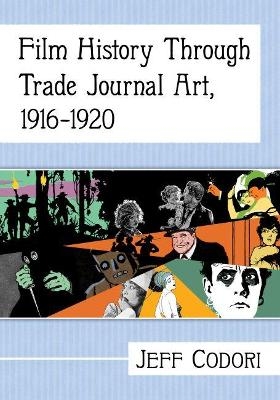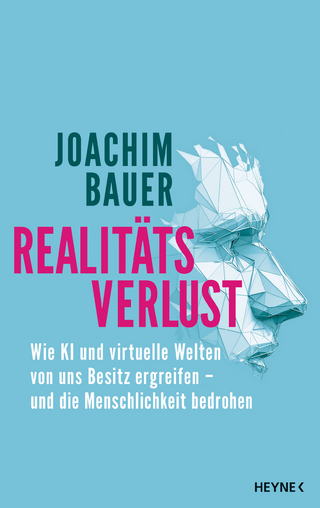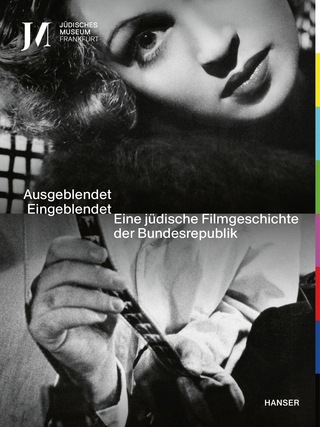
Film History Through Trade Journal Art, 1916-1920
McFarland & Co Inc (Verlag)
978-1-4766-7617-3 (ISBN)
The period in film history between the regimentation of the Edison Trust and the vertical integration of the Studio System—roughly 1916 through 1920—was a time of structural and artistic experimentation for the American film industry. As the nature of the industry was evolving, society around it was changing as well; arts, politics and society were in a state of flux between old and new. Before the major studios dominated the industry, droves of smaller companies competed for the attention of the independent exhibitor, their gateway to the movie-goer. Their arena was in the pages of the trade press, and their weapons were their advertisements, often bold and eye-catching.
The reporting of the trade journals, as they witnessed the evolution of the industry from its infancy towards the future, is the basis of this history. Pulled from the pages of the journals themselves as archived by the Media History Digital Library, the observations of the trade press writers are accompanied by cleaned and restored advertisements used in the battle among the young film companies. They offer a unique and vital look at this formative period of film history.
Jeff Codori is the creator of the Colleen Moore Project, a website devoted to strengthening the actress's place in cinematic history, and to finding new sources of information about her.
Table of Contents
Acknowledgments ix
Preface 1
The Early Years 7
1916
1. Universal: “The Name ‘Red Feather’ … Will Be Substituted.”
2. The Mysteries of Myra: “We do not need to use superlatives….”
3. Bluebird Photoplays: “…THE PLAY is always greater than the star.”
4. Pathé Exchange: “…the House of Serials, has done it again.”
5. Lewis J. Selznick Productions: “The box-office is the greatest critic of ’em all….”
1917
6. Artcraft Pictures Corporation: “Since its inception, Artcraft has faithfully carried out its promise for ‘the biggest and best’ in motion pictures.”
7. Butterflies and Red Feathers: “…It is possible to put out five reels of action, plot development, suspense, lavish sets, superb action and brilliant directions without robbing the Exhibitor of all chance to make his legitimate profit.”
8. Triangle Film Corporation: “The Ultimate in Motion Pictures!”
9. Bluebirds and Super-Bluebirds: “A Bluebird that far surpasses the average high-class feature.”
10. Paramount–Mack Sennett’s Giggle Factory: “Here everything from a giggle to a guffaw is made….”
1918
11. Pathé Exchange: “…First-class productions gauged from every angle—star, cast, story, direction and box office appeal.”
12. Bluebirds, Jewels and Universal Special Attractions: “It is your patriotic duty to show this great Special, and make a bag full of money at the same time.”
13. The Master Mystery: “…we have a showman with predominant drawing power, a man who stands alone in his work, who has practically mystified the entire world, whose name is a household word.”
1919
14. Universal: “‘I see in the future great things for Universal productions.’”
15. Robertson-Cole: “Supreme Quality Plus Unequaled Service Always the Robertson-Cole Standard.”
16. Pathé Exchange: “Serial making demands specialization. Pathé has made of it a science…. Pathé serials will pay you!”
1920
17. Selznick Pictures, Select Pictures, National Pictures and National Picture Theaters: “What Happened to Troy Can Happen
Schenectady Too.”
18. Equity Pictures: “Trade Papers bulge with Lurid Advertising—Dictionaries are stripped of every Adjective—and ‘Promises’ are fired right and left.”
19. Robertson-Cole: “…Uncovers a Lot of Good Things in A BeautifulFour-Page Insert….”
20. Pathé Exchange: “How they thrill as they see the stirring action; how they exult at the escape of the heroine from danger, at the triumph of innocence over evil!”
21. Loew-Metro: “At Broadway and 45th Street Marcus Loew is erecting a theatre and sixteen-story office building…. ‘Strange,’ comments Chigot, ‘that a Loew building should be so high’.”
22. Joan Film Sales Company: “…In contradiction to the pessimism in certain quarters … [Joan] finds prospects bright…”
23. Universal: “Exploitation begins at the studio.”
Into the Future 157
Appendix A: Artist Biographies 169
Appendix B: Film Synopses 173
Chapter Notes 241
Bibliography 263
Index 265
| Erscheinungsdatum | 31.12.2019 |
|---|---|
| Zusatzinfo | 190 photographs |
| Verlagsort | Jefferson, NC |
| Sprache | englisch |
| Maße | 178 x 254 mm |
| Themenwelt | Kunst / Musik / Theater ► Design / Innenarchitektur / Mode |
| Kunst / Musik / Theater ► Film / TV | |
| Sozialwissenschaften ► Kommunikation / Medien ► Medienwissenschaft | |
| ISBN-10 | 1-4766-7617-8 / 1476676178 |
| ISBN-13 | 978-1-4766-7617-3 / 9781476676173 |
| Zustand | Neuware |
| Haben Sie eine Frage zum Produkt? |
aus dem Bereich


